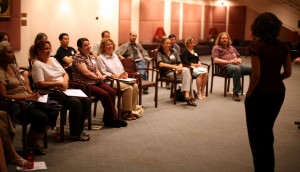Here’s a snippet from a live presentation we did for the Chicago Chapter of the American Society for Training and Development. The topic was Change Management. The Interactors are Dan Feldt and Ta-Tanisha Jordan; I’m facilitating. It was a lively crowd!
How we learn
11 ways trainers can create terrific role plays
Recently, I had some exciting conversations with people who are trying to create more valuable role plays within their organizations. Talking with them reminded me of this article I wrote for the ASTD magazine Training Today a few years back. It’s a compilation of many things Dan and I have learned over our years of creating interactive learning, adapted for trainers who don’t have professional actors to work with, as we do. I’m reposting the article with permission.
You know that role plays are a wonderful tool for turning theory into practice. They can answer that crucial question, “How does this apply to me?” By giving learners a chance to try out new behaviors in a controlled setting, they can jump-start the application of new learning back on the job. They get people out of their chairs and into action.
So why do so many learners hate role plays? You’ve seen it happen: participants groan when a role play is announced. You can’t get a volunteer, so you have to force someone to come up. The role players are too easy on each other, or they give up too soon – or they just undermine the whole exercise with joking or hostility. What’s going on here?
It’s simple: they’re afraid they’re going to make fools of themselves. As a trainer, you know that most people get anxious when they have to get up in front of a group. They’re afraid they’ll be judged. When that group consists of their peers and co-workers, it feels even riskier. And when they’re not sure what they’re supposed to be doing, that anxiety goes sky-high.
You can reduce the risk of role plays. You can’t take away people’s performance anxiety, but you can minimize it through the way you design, set up, and facilitate role plays. You can create an atmosphere of humor and experimentation, and you can ensure success for all participants – no matter what mistakes they make.
Here are 11 ways to make role plays work for you. We’ve divided these tips into the three phases of creating a role play: Design (how you structure the exercise), Instructions (how you explain the exercise to participants), and Facilitation (how you work with the role players as the exercise is taking place).
Design:
- Be specific. Most role plays fail because they’re too general, and people don’t know what to do. Choose the circumstances of the role play carefully. Fill in lots of detail. For example, if it’s a customer-service training, don’t just ask someone to play a complaining customer. Tell the role-players exactly what the issue is: “You’re a credit-card customer who asked last month to have an erroneous charge removed from her bill. You just got the new bill, and the charge is still there.” And to the person playing the customer service rep: “Two people are out sick, and you’re covering for them, even though you should have gone to lunch a half-hour ago. The last person you talked to hung up on you.” This level of detail helps role players believe in the action. They’re less likely to be distracted by their own nerves or by others’ reactions.
- Make the role play situation important to the characters. The stakes should be high. (For example, a valuable employee is ready to quit because his manager never recognizes his achievements. The manager already has been warned by her boss about too much turnover in her department.) When the outcome is important to the characters, the exercise has more energy and interest for the role players and for those watching.
- Target the learning points. Make sure the situation you choose will make the role players deal with the behavior you want to teach. Because new learning feels uncomfortable, most role players will try to avoid acting it out. Close the escape hatches by picking a situation that must be solved by putting the learning points into practice.
- Focus on a small, important piece of behavior. Don’t try to do too much in a single role play. If you’re training people in a process, work it section by section (for example, in sales training, focus on establishing rapport, then on asking probing questions, etc. – perhaps with different participants playing the salesman in each section).
- Don’t be afraid of “negative models.” You can inject a lot of humor – and learning – into a workshop by asking people to “do everything wrong.” For example, in the customer service situation, ask the person playing the rep to come up with three bad ways to handle the complaining customer (such as sounding bored, using sarcasm, and shouting at her), and then let the participants discuss why those approaches didn’t work – the consequences of not using the new learning. You can generate a lot of energy with this exercise, and the humor helps break the ice for further role playing.
Instructions:
- Take role players off the hook. Tell them, “You’re not you in this role play, you’re somebody else just like you.” Refer to the character by another name, not the role player’s name. Creating distance between the character and the self means participants don’t have to own any errors they make – they’re not really “their” mistakes. Sometimes it helps to set role plays at a fictional company similar to the real one.
- Strive for a better – not a perfect – interaction. Let participants know that you’ll applaud any success, even a small one.
- Bring a sense of fun to the exercise. Keep it light. People learn better through humor, liveliness and enjoyment.
- Share the risk. Let role players work in teams, sharing solutions and coaching each other. Have the team come up to the front, so the person who is actually doing the role play can turn to his team for advice. Have team members replace each other in the role play, as in tag-team wrestling, so no one has to do the entire exercise by himself.
Facilitation:
- Applaud. Praise and validate the role players’ work. Thank them for their contribution. Point out where they used the learning points and how it led to a successful outcome. Applaud them for taking the risk of role playing.
- When “failures” happen, focus on the process rather than the person. When role players don’t follow the learning points, say (for example), “Well, that certainly put him in his place. What might be some of the drawbacks to handling it that way?” Discuss the behaviors. Have the role players try the same situation again, with suggestions from other participants. Thank the role players for providing good material for discussion. After all, the whole group will learn from things that don’t work out, as well as from those that do.
Role plays can be a great teaching tool, with your help. You can design, introduce and facilitate them so learners
- know what they’re supposed to be doing
- aren’t afraid of being judged
- feel free to experiment and have fun.
With less anxiety and more targeted learning, who knows? Maybe role plays will become your company’s favorite learning technique.
Interface or face-to-face learning?
What can we as learning and development professionals learn from the decision of Yahoo’s CEO, Marissa Mayer, to end the work-from-home policy for 200 Yahoo employees? In explaining her decision she said, “people are more productive when they’re alone,” and then continued, “but they’re more collaborative and innovative when they’re together. Some of the best ideas come from pulling two different ideas together.” It would be wise to keep her words in mind when developing learning programs.
Marissa Mayer was a rising star at Google before she became Yahoo’s CEO. Yahoo and Google are two companies whose existence depends on the sharing of information over the Internet. However, she’s keenly aware of the limitations of the platform. People are more productive alone when consuming information, understanding concepts, memorizing lists and procedures – all necessary to do their jobs effectively. But when it comes time to use this knowledge in creative applications, employees need to come together face-to-face to pull different ideas together.
Here’s where learning professionals can use Ms. Mayer’s insight. We can also use this blended approach to maximize the effectiveness of our program design. We need to take advantage of both the interface and the face-to-face. Learners can work independently to absorb knowledge and come together in the classroom to apply it in innovative ways.
Finally, when we bring participants together who have gained information from the e-learning portion of the training, we need to refocus their face-to-face time. Instead of facing the facilitator, participants need to face each other and through experiential exercises pull ideas together and make the learning their own.
Let’s keep in mind the reason behind Ms. Mayer’s decision. She said, ‘I don’t want to change [Yahoo’s] culture. I want to amplify its greatness.” Let’s use the strengths of both e-learning and the face-to-face classroom to do the same for learning transfer.
This I believe
I’ve been very busy with an exciting project, so my reading of Imagine has had to wait.
But in the meantime, I thought I’d post my favorite quotation of all. It’s been a credo and an inspiration for me for many years. It’s from T. H. White’s marvelous novel The Once and Future King.
Wart (who doesn’t know he is the future King Arthur) is angry and depressed because his foster brother Kay will become a knight, while he will only serve Kay as his squire. Merlyn, Wart’s magical teacher, consoles him:
The best thing for being sad…is to learn something. That is the only thing that never fails. You may grow old and trembling in your anatomies, you may lie awake at night listening to the disorder in your veins, you may miss your only love, you may see the world about you devastated by evil lunatics, or know your honor trampled in the sewers of baser minds. There is only one thing for it then — to learn….That is the only thing that the mind can never exhaust, never alienate, never be tortured by, never fear or distrust, never dream of regretting. Learning is the thing for you.
Amen.
Can computers give you the practice you need?
 More provocative stuff from Dan Goleman:
More provocative stuff from Dan Goleman:
Computer-aided instruction, a current vogue in training, has limits when it comes to offering practice for emotional competence. …computer-aided techniques are generally better suited for training in technical skills than for developing personal and interpersonal capabilities.
“People say you can sit at your computer, assess yourself, and find out how to develop a competency,” observes Richard Boyatzis, of Case Western Reserve University. “But you can’t do this without relationships — you can’t learn this in isolation.”
Social networking has helped learners stay in relationship with each other, sometimes even in real time. And the technology of online interaction is improving constantly.
But for me, there are two issues with interpersonal practice:
1) Are you practicing in the mode that you’ll be working in?
2) Is there room for the spontaneous and unexpected?
By mode, I mean that if you’re managing people via phone (for example), you should be practicing your phone communication skills, You’ve only got your voice to work with, so you’ll need practice in the subtleties of listening, imparting information, getting and giving feedback, and so on. You’ve got similar restrictions with email, teleconferencing, Skype, etc.
Same for in-person relationships. If you’re in the same room with people every day, practicing virtually won’t give you the skills you need. We pick up all sorts of cues in the face-to-face encounter that aren’t present when technology is between us.
To my second point: online learning tends to be standardized, which makes sense, because we need numbers of people to have a similar experience with the material. But human encounters are anything but standardized. People are constantly surprising; conversations we expected to be calm can escalate, and meetings we think we’re prepared for often veer onto a different path.
For practice, it’s much easier for live people to simulate these unexpected interpersonal twists. (Our Interactors are brilliant at it.) Even computer games have a limited number of possible responses, while the real human factor is infinite. So I argue that practice with real human beings, whether in person, over the phone, or even in teleconferencing, adds a level of realism that can’t be reached in any other way.
Learners deserve to try out new skills in a situation that recreates the complexity that they’ll be dealing with back on the job. Nothing can replace practicing with real live people.
Use it or lose it
 From the current Discover magazine (not yet online) on why teaching by lecture doesn’t work:
From the current Discover magazine (not yet online) on why teaching by lecture doesn’t work:
“The latest cognitive science research on effective learning…points to more interactive approaches that include immediately and repeatedly putting new information to use.”
The author, David Freedman, quotes Carl Wieman, Nobel Prize-winning associate director of the Office of Science and Technology at the White House: “They say [the lecture] is the way it’s always been done, and it was good enough for them, so it’s good enough for their students.”
Freeman goes on:
Were this attitude to hold in medicine, we would still be bloodletting; in physics,we would be trying to reach the moon with very large rubber bands, and in economics we would still be suffering major worldwide financial crashes. (Well, physics and medicine are advancing, anyway.)
Why do some of us still think that being talked at (even online) constitutes knowledge transfer? We wouldn’t let people work with dangerous equipment without practicing first. Why do we assume that learners can simply hear about how to handle a difficult conversation and then be able to do it weeks later while under stress?
All true learning needs a component that goes beyond the theoretical: some form of practice. When it comes to new knowledge, it really is “use it or lose it.”
We live by stories
In reading a fascinating profile of brain researcher Dr. Michael Gazzaniga, I came across this:
across this:
The left hemisphere takes what information it has and delivers a coherent tale to conscious awareness. It happens continually in daily life, and most everyone has caught himself or herself in the act — overhearing a fragment of gossip, for instance, and filling in the blanks with assumptions.
The brain’s cacophony of competing voices feels coherent because some module or network somewhere in the left hemisphere is providing a running narration…. We narrate our lives, shading every last detail, and even changing the script retrospectively, depending on the event, most of the time subconsciously. The storyteller never stops, except perhaps during deep sleep.
In other words, story is how our brains organize the vast amount of information coming to us in each moment – as well as the competing ways various parts of our brains interpret what we perceive. Apparently, we need stories just to exist as conscious beings.
So it stands to reason that story is a powerful tool for learning, for adults as well as kids.
We’ve found that having Interactors demonstrate specific workplace situations (say, a manager having to deliver bad news to her team) allows learners to share a common story. They can talk about the situation we’ve presented, rather than reveal their own struggles at work. And each learner can fill in the story line with his own experiences, so he takes away useful ideas and behavior to try out back on the job.
Of course, we’ve found that practice is crucial for actually applying new learning, and creating effective practice is our mission. And the most powerful way to practice is within a strong story.
People sitting in a classroom are already telling themselves stories about what they’re experiencing. Why not harness that power to further the learning?
Postscript: Here’s comics great John Ostrander on how everything is story.
From “Ha-ha” to “Aha!”
New study on puzzles, problem-solving and laughter, demonstrating that people find it easier to solve puzzles through a flash of insight after they’ve watched something funny. I love this from two points of view:
As a puzzle maniac, I agree that even thinking about a good one (cryptic crosswords are my drug of choice) induces a pleasant mind-state – something they found in the study. And that moment of insight when the answer suddenly appears is one of the great joys of life, to me.
And as a creator of leadership-skills practice sessions which always combine laughter with serious practice, I constantly see how insight follows the loosening-up process of watching a funny live scene.
Glad to have the neurology to prove it!
You can’t punish people into learning
British corporate change expert David Bovis wrote in a discussion on LinkedIn, “Neurologically / psychologically, we are ‘designed’ to learn from mistakes, and we learn quicker from environments that provide positive reinforcement, forgiveness & understanding following mistakes.” He goes on to give the (wonderfully vivid) example of how we encourage babies learning to walk. No one ever says, “You little idiot, you’ll never walk. Why even try again?” And yet our feedback and evaluation systems tend to focus on what we’ve done wrong, in a punitive way.
psychologically, we are ‘designed’ to learn from mistakes, and we learn quicker from environments that provide positive reinforcement, forgiveness & understanding following mistakes.” He goes on to give the (wonderfully vivid) example of how we encourage babies learning to walk. No one ever says, “You little idiot, you’ll never walk. Why even try again?” And yet our feedback and evaluation systems tend to focus on what we’ve done wrong, in a punitive way.
That reminds me of Marshall Goldsmith‘s wonderful Feedforwardexercise, which we’ve used with a number of different groups: clients, our religious community, and even just between Dan and me. Instead of focusing on the past (which we can’t change, anyway), feedforward encourages us to consider ways that we can do better as we move ahead.
If you haven’t tried it, I urge you to check it out. Marshall’s clever format helps stop our usual resistant brain-chatter and opens us up to true listening and real possibility. People report feeling truly cared for after the exercise and tend to come away with a few good ideas for improving their lives. One baby step at a time.
Crowdsourcing the answer
Online training has become an accepted, often cost-efficient way of training in the corporate setting. E-learning allows people to work at their own pace, during their own available time. But what’s lost?
I thought back to a recent workshop we gave, in which 24 newly-minted supervisors watched each other deal with various realistic management situations, live and impromptu. Participants commented on how valuable it was to see how other people handle things – even if their style is different from yours (or perhaps especially so!). Even though back on the job these folks will often have to act alone, the collaboration they experience in training helps give them a repertoire of possible approaches that they’re more likely to remember when they need them.
We often emphasize the practice aspect of our workshops, and of course that’s vital: nothing makes learning stick like actually trying it out. But the group process may be equally important for topics (like supervisor skillls) that involve social interaction. In a culture that still tends to overemphasize the individual, it’s useful to reaffirm the wisdom of crowds.
Photo by Jill Brazel of a Workplace Interactors program




